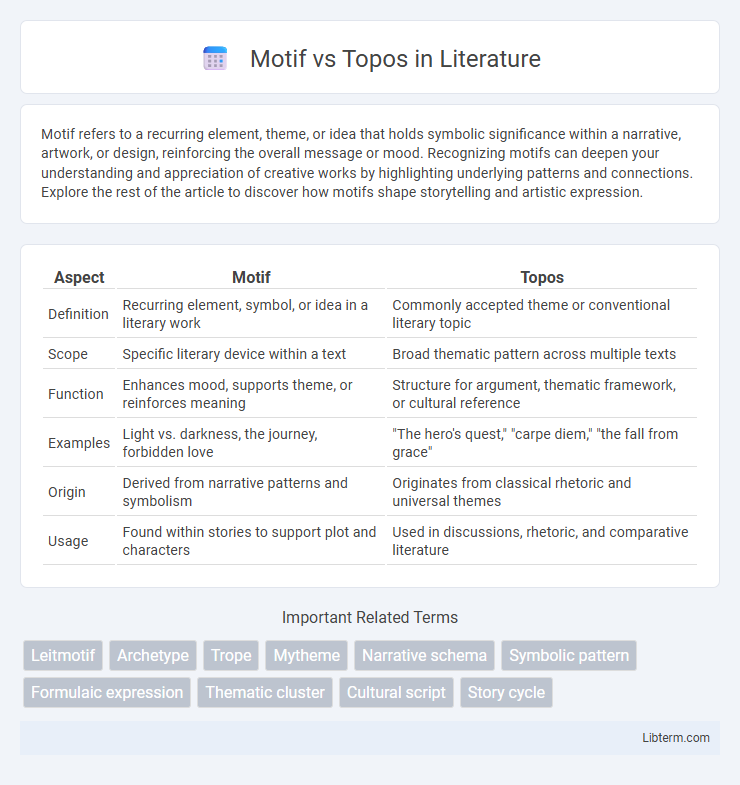Motif refers to a recurring element, theme, or idea that holds symbolic significance within a narrative, artwork, or design, reinforcing the overall message or mood. Recognizing motifs can deepen your understanding and appreciation of creative works by highlighting underlying patterns and connections. Explore the rest of the article to discover how motifs shape storytelling and artistic expression.
Table of Comparison
| Aspect | Motif | Topos |
|---|---|---|
| Definition | Recurring element, symbol, or idea in a literary work | Commonly accepted theme or conventional literary topic |
| Scope | Specific literary device within a text | Broad thematic pattern across multiple texts |
| Function | Enhances mood, supports theme, or reinforces meaning | Structure for argument, thematic framework, or cultural reference |
| Examples | Light vs. darkness, the journey, forbidden love | "The hero's quest," "carpe diem," "the fall from grace" |
| Origin | Derived from narrative patterns and symbolism | Originates from classical rhetoric and universal themes |
| Usage | Found within stories to support plot and characters | Used in discussions, rhetoric, and comparative literature |
Understanding Motif and Topos: Definitions
Motif refers to a recurring element, theme, or image that appears throughout a literary work, symbolizing broader concepts or emotions. Topos, derived from classical rhetoric, denotes a conventional theme or common argumentative place used across various texts for constructing meaning and engaging with cultural ideas. Understanding the distinction between motif and topos helps in analyzing literature by identifying specific repeated symbols (motifs) versus general thematic frameworks (topoi) employed by authors.
Historical Origins of Motif and Topos
Motifs originated in early oral traditions and folk tales, serving as recurring narrative elements that convey cultural values and collective memory across generations. Topoi, rooted in classical rhetoric, emerged as generic argumentative themes or commonplaces used by ancient Greek and Roman orators to structure discourse effectively. The historical development of motifs is tied to storytelling and myth-making, whereas topoi are firmly grounded in rhetorical theory and the art of persuasion.
Key Differences Between Motif and Topos
Motifs are recurring elements or themes in literature and art that convey symbolic meaning, while topos refers to conventional rhetorical themes or commonplaces used in argumentation and composition. A key difference is that motifs primarily function as narrative or visual symbols, whereas toposes serve as strategic frameworks for persuasion and thematic organization. Motifs often evolve within a particular cultural or artistic context, whereas toposes are more standardized and found across various texts and genres as rhetorical devices.
The Role of Motif in Literature and Art
Motifs serve as recurrent elements that enhance thematic depth and emotional resonance in literature and art, often symbolizing broader concepts or cultural values. Unlike topos, which are conventional themes or rhetorical figures, motifs function as specific, tangible details that unify a narrative or visual composition. The strategic repetition of motifs creates layers of meaning and reinforces the work's central ideas, contributing to its interpretive richness.
The Significance of Topos in Rhetoric and Culture
Topos serves as a foundational concept in rhetoric and culture, providing universal thematic frameworks that guide argumentation and interpretation. Unlike motifs, which are recurring elements or symbols within specific artworks or narratives, topos shapes the broader cultural discourse by offering recognizable patterns that resonate across diverse contexts. This rhetorical tool enables speakers and writers to connect with audiences through shared cultural knowledge, enhancing persuasion and meaning-making.
How Motifs Shape Narrative and Theme
Motifs, recurring elements such as symbols, images, or phrases, shape narrative and theme by reinforcing central ideas and emotional undercurrents throughout a text, creating cohesion and depth. They provide patterns that guide readers' interpretation, highlighting character development, cultural contexts, or moral lessons integral to the story. Unlike topos, which function as conventional or rhetorical themes, motifs dynamically evolve within the narrative, allowing nuanced exploration of themes and contributing to the work's unique voice and meaning.
Topoi as Universal Ideas Across Genres
Topoi, or commonplaces, serve as universal ideas transcending specific genres, enabling writers to draw from a shared pool of thematic concepts such as love, death, or conflict. Unlike motifs, which are recurring symbols or elements specific to a particular work or genre, topoi function as foundational rhetorical building blocks that shape discourse across literature, philosophy, and rhetoric. Their versatility allows authors to adapt and reinterpret universal human experiences, creating connections that resonate across diverse cultural and historical contexts.
Examples of Motif and Topos in Classic Works
Motifs in classic literature, such as the recurring "forbidden fruit" in *Paradise Lost* and the "green light" in *The Great Gatsby*, symbolize deeper themes and emotions central to the narrative. Topoi, or topoi loci, represent conventional themes or settings found in multiple works, like the "hero's journey" archetype in *The Odyssey* and the "garden of paradise" motif recurring in medieval literature. Both motifs and topoi enhance thematic depth and cultural resonance, illustrating how authors embed universal ideas within unique story elements.
The Interplay of Motif and Topos in Modern Media
Motif and topos serve distinct yet complementary roles in modern media, with motifs representing recurring visual or thematic elements, while topos encapsulates conventional narrative themes or rhetorical commonplaces. The interplay of motif and topos enhances storytelling by reinforcing cultural archetypes through repeated symbols and situational frameworks, thus creating layered meanings in films, literature, and digital content. This dynamic interaction enables creators to evoke familiarity and innovation simultaneously, deepening audience engagement and interpretive possibilities.
Why Distinguishing Motif vs Topos Matters
Distinguishing motif from topos matters because motifs function as recurring symbolic elements in literature and art, while topos refers to conventional themes or commonplaces shaping narrative structures and rhetorical strategies. Understanding their differences enhances literary analysis by clarifying how individual symbols contribute to broader cultural or thematic patterns. This distinction enriches interpretation, enabling scholars to trace how specific motifs evoke emotional responses within established topoi across various texts.
Motif Infographic

 libterm.com
libterm.com